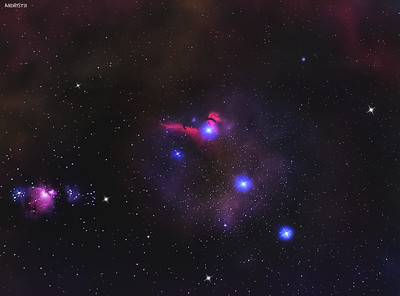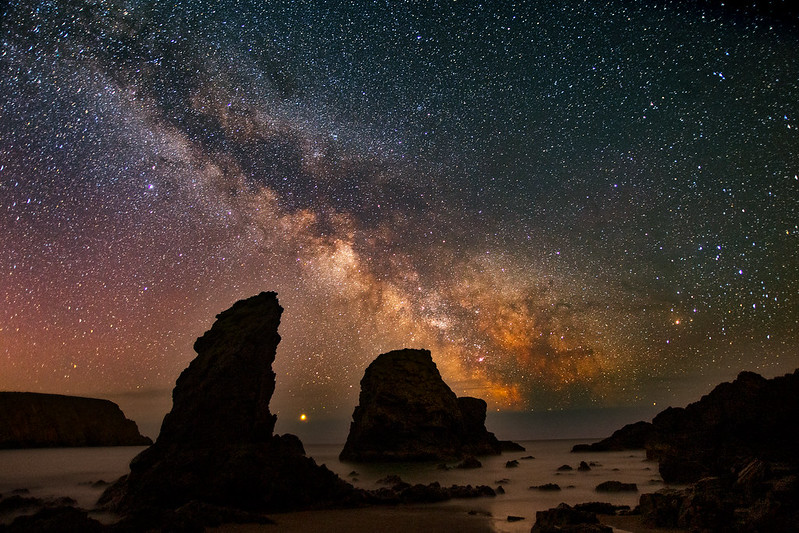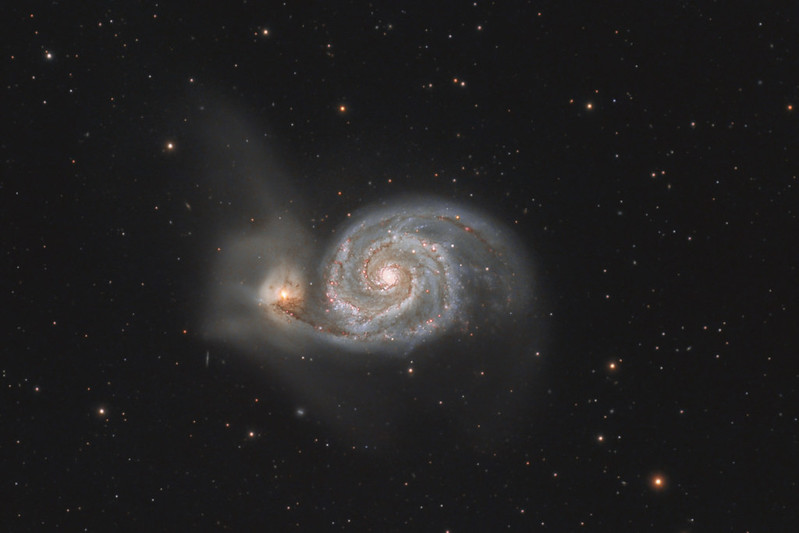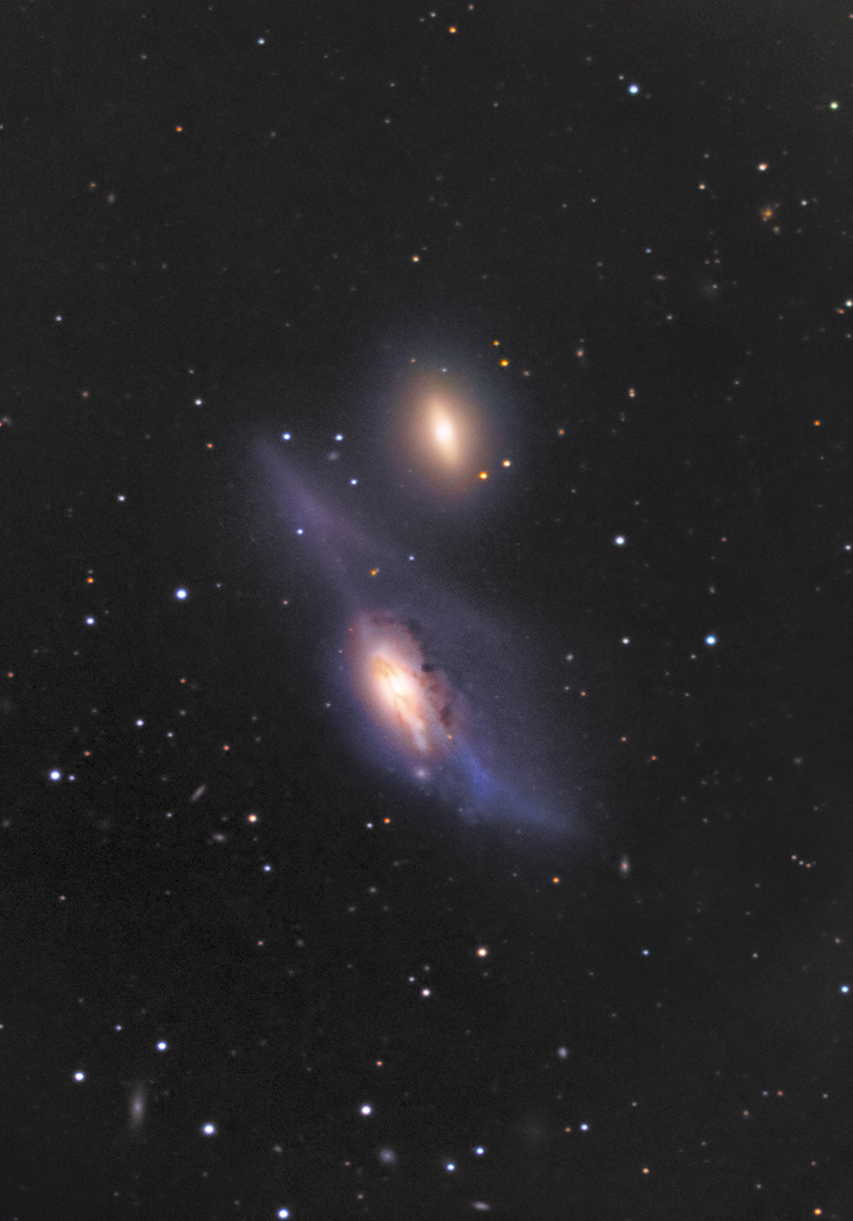 LBN106 by Raul Villaverde, en Flickr
LBN106 by Raul Villaverde, en FlickrSubmissions: 2021 March
Re: Submissions: 2021 March
Sinus Iridum – The Bay of Rainbows. In this image clearly showing its classical Jewelled Handle, comprising an illusionary setting for 5 gemstones, only visible for a few short hours each month when the terminator passes over the basin. The low sunlight illuminates the Jura mountains with a Clair-Obscure effect at 2 days after first quarter setting the valleys in deep shadow while highlighting the prominent peaks creating the visual effect of a Jewelled Handle. It is a highly prominent and imposing feature which stands out against a background of darkness which is difficult to image correctly while retaining the low Dorsa wrinkled wave like features within the bay that also come to prominence at this time. Another hugely important and stand out feature of this image is the “Moon Maiden” first brought to prominence by the Italian astronomer Giovanni Cassini in a drawing published in 1679. “She” can be seen in the structure of the Promontorium Heraclides overlooking the peaceful bay. (to best view the Maiden, rotate the image 90 degrees counter clockwise). Other standout features are the Promontorium Laplace, the small crater Laplace A at the entrance to the bay and the crater Bianchini in deep shadow on the crest line of the Montes Jura. To the right of the image are the craters Helicon and Le Verrier.
Equipment used.
Skymax 180/2700 Mak-Cas. ASI294 CM Pro. imaged with Sharpcap in SER format with a capture area of 1024x768 5000 frames 24/sec no guiding. iOptron CEM 60 mount. 20% stacked in AutoStakkert 3 processed in Photoshop.
Imaged at 19:00 CET 22/02/2021 Torrevieja Spain.
Equipment used.
Skymax 180/2700 Mak-Cas. ASI294 CM Pro. imaged with Sharpcap in SER format with a capture area of 1024x768 5000 frames 24/sec no guiding. iOptron CEM 60 mount. 20% stacked in AutoStakkert 3 processed in Photoshop.
Imaged at 19:00 CET 22/02/2021 Torrevieja Spain.
-
Joshua Rhoades
Re: Submissions: 2021 March
Last edited by bystander on Tue Mar 09, 2021 6:10 pm, edited 1 time in total.
Reason: All <img> tags require an image url not a page url. Uploaded image as an attachment.
Reason: All <img> tags require an image url not a page url. Uploaded image as an attachment.
-
andrystix
Re: Submissions: 2021 March
 Orion Molecolar Complex by Andrea Amici - Andrystix
Orion Molecolar Complex by Andrea Amici - AndrystixHere is my very first attemp of Orion Molecolar Nebula Complex taken directly from my balcony in the middle of the light pollution in Ancona, Italy (7-3-21).
Exif: Nikon D750 (modded) with AF-S NIKKOR 70-200mm f/2.8G ED VR II
Technique: 650 shots, 13sec, ISO 800, f/4. 128 darks, flats and bias. Stacked with DSS and fixed on PS.
Social: @andrystix on Facebook, Instagram and Flickr
Re: Submissions: 2021 March
Eagle Nebula cropped in to show Pillars of Creation.
Images over 6 hours March 2021 from Bortle 8 North Texas.
Celestron 9.25 Edge Hd, zwo 294mmpro, chroma narrowband (3nm) filters, Cem70 mount.
Each filter was a set of 300s subs, approx 2 hours worth each. The images were stacked in deep sky stacker, combined in Hubble Palette in Pix insight and remaining colors and sharpening etc completed in Photoshop.
Images over 6 hours March 2021 from Bortle 8 North Texas.
Celestron 9.25 Edge Hd, zwo 294mmpro, chroma narrowband (3nm) filters, Cem70 mount.
Each filter was a set of 300s subs, approx 2 hours worth each. The images were stacked in deep sky stacker, combined in Hubble Palette in Pix insight and remaining colors and sharpening etc completed in Photoshop.
Last edited by Stevemr2t on Wed Mar 10, 2021 1:44 pm, edited 1 time in total.
-
thomasroell
- Ensign
- Posts: 28
- Joined: Tue Oct 27, 2020 7:23 pm
Re: Submissions: 2021 March
The march 2021 conjuction of the Pleiades, M45, and Mars.
This was taken with my DSLR from my home in The Netherlands March 6th.
I hope you like it!
RGB 30 x 120 sec ISO1600
🖥 Edited in AstroPixel Processor, Starnet++, Photoshop and Lightroom
.
 Sky-watcher HEQ5, Sharpstar 61EDPH Triplet APO, Svbony 60 mm guidescope with a ZWO ASI120MM guidecamera.
Sky-watcher HEQ5, Sharpstar 61EDPH Triplet APO, Svbony 60 mm guidescope with a ZWO ASI120MM guidecamera.
🕹ZWO ASIAIR
 astromodified Canon EOS 6D, Optolong L-Extreme filter
astromodified Canon EOS 6D, Optolong L-Extreme filter
Kind regards,
Thomas Röell
Instagram: @pilot_astro
This was taken with my DSLR from my home in The Netherlands March 6th.
I hope you like it!
RGB 30 x 120 sec ISO1600
🖥 Edited in AstroPixel Processor, Starnet++, Photoshop and Lightroom
.
🕹ZWO ASIAIR
Kind regards,
Thomas Röell
Instagram: @pilot_astro
Re: Submissions: 2021 March
 M104 by Dave & telescope, on Flickr
M104 by Dave & telescope, on FlickrM104 Galaxy
15 hours LRGB from Mayhill, NM
Further capture details are on the Flickr page
Thanks for looking!
Dave
Re: Submissions: 2021 March
Bok Globules of the Rosette Nebula:
Click on above for larger image.
More info @ https://www.kinchastro.com/rosette-nebula.html
Click on above for larger image.
More info @ https://www.kinchastro.com/rosette-nebula.html
The Tarantula and its Web
The Tarantula and its Web (Doradus 30)
 Tarantual Finalsigned4alt by Logan Carpenter, on Flickr
Tarantual Finalsigned4alt by Logan Carpenter, on Flickr
Unlike most of the nebulae in the night sky, the Tarantula nebula is not located in our galaxy
but is 160,000 light years away in the Large Magellanic Cloud, a satellite galaxy of our Milky Way galaxy.
It is so bright that if it were as close to earth as the Orion nebula, it would cast visible shadows.
It is said to be one of the most active starburst regions in our local group of galaxies and has one of the largest
H II regions. At is center lies the star cluster NGC2070 estimated to contain more than 500,000 stars.
Location : Auckland, New Zealand
Credit: Logan Carpenter
Taken over three nights 2/3/21 to 4/3/21
Telescope: Skywatcher Esprit 120ED
Camera: ASI1600mm pro
Filters: Optolong Ha and Oiii
Mount: iOptron CEM60.
Guides scope: Orion 60mm
Guide camera : ASi290mono mini
Ha 47 x 5min exposure
Oiii 40 x 5 min exposure
Total integration 7.2 hours
Processing:
APP, Pixinsight and Photoshop
Astrobin link : https://www.astrobin.com/qs36eh/?nc=user
 Tarantual Finalsigned4alt by Logan Carpenter, on Flickr
Tarantual Finalsigned4alt by Logan Carpenter, on FlickrUnlike most of the nebulae in the night sky, the Tarantula nebula is not located in our galaxy
but is 160,000 light years away in the Large Magellanic Cloud, a satellite galaxy of our Milky Way galaxy.
It is so bright that if it were as close to earth as the Orion nebula, it would cast visible shadows.
It is said to be one of the most active starburst regions in our local group of galaxies and has one of the largest
H II regions. At is center lies the star cluster NGC2070 estimated to contain more than 500,000 stars.
Location : Auckland, New Zealand
Credit: Logan Carpenter
Taken over three nights 2/3/21 to 4/3/21
Telescope: Skywatcher Esprit 120ED
Camera: ASI1600mm pro
Filters: Optolong Ha and Oiii
Mount: iOptron CEM60.
Guides scope: Orion 60mm
Guide camera : ASi290mono mini
Ha 47 x 5min exposure
Oiii 40 x 5 min exposure
Total integration 7.2 hours
Processing:
APP, Pixinsight and Photoshop
Astrobin link : https://www.astrobin.com/qs36eh/?nc=user
Re: Submissions: 2021 March
M81 and M82 galaxies in Ursa Major
Credit: Marco Cosmacini - Osservatorio Villaverde
Credit: Marco Cosmacini - Osservatorio Villaverde
Marco Cosmacini
Villaverde Observatory
Italy
Villaverde Observatory
Italy
-
goodastronomy
- Ensign
- Posts: 24
- Joined: Wed Sep 19, 2018 11:47 am
Re: Submissions: 2021 March
Happy to present my recent images from Winter 2020/21 from in and around the Orion Constellation. These are from our dual remote systems in Fort Davis, Texas consisting of: Primary - Planewave 14" CDK/Paramount ME2/FLI PL16803 with Chroma filters Secondary - Stellarvue 130/Paramount Mx+/ASI533MC:
First up is VDB 38, or the "Moldy Strawberry" as some refer to it:
Then NGC 1788, which I had originally intended as a 4 panel mosaic but we ran out of time:
Finally, SH2-278:
All images copyright Casey Good/Steve Timmons
First up is VDB 38, or the "Moldy Strawberry" as some refer to it:
Then NGC 1788, which I had originally intended as a 4 panel mosaic but we ran out of time:
Finally, SH2-278:
All images copyright Casey Good/Steve Timmons
Re: Submissions: 2021 March
MILKY IN THE DUST
About 4 years ago I've incidentaly took a picture of Lyra region which drived to the verifying if the dust I got on a picture is really present there.
This drove me to this mosaic which is a result of i.a 30-35h of imaging time during three years and about a year of trying to find a way to process it, which sometimes, due to differences in sky conditions and locations between different sessions, seemed to be impossible to finalize.
It is indisputable that the Milky Way itself is a unique and graceful object, but the possibility of showing all the dust that surrounds it was what drove me on this project most. I hope you enjoy it.
Credit: Ireneusz Nowak
All panels has been taken with Samyang 135m/2 lens, Nikon D610 and modded Nikon D610.
Time: Summer and Autumn of 2017/2018/2019.
Location: Hungary and Southern Poland
Astrobin location of the picture: https://www.astrobin.com/full/xx7p9d/0/
Author Astrobin link: https://www.astrobin.com/users/iro/
Kind Regars,
Ireneusz Nowak
About 4 years ago I've incidentaly took a picture of Lyra region which drived to the verifying if the dust I got on a picture is really present there.
This drove me to this mosaic which is a result of i.a 30-35h of imaging time during three years and about a year of trying to find a way to process it, which sometimes, due to differences in sky conditions and locations between different sessions, seemed to be impossible to finalize.
It is indisputable that the Milky Way itself is a unique and graceful object, but the possibility of showing all the dust that surrounds it was what drove me on this project most. I hope you enjoy it.
Credit: Ireneusz Nowak
All panels has been taken with Samyang 135m/2 lens, Nikon D610 and modded Nikon D610.
Time: Summer and Autumn of 2017/2018/2019.
Location: Hungary and Southern Poland
Astrobin location of the picture: https://www.astrobin.com/full/xx7p9d/0/
Author Astrobin link: https://www.astrobin.com/users/iro/
Kind Regars,
Ireneusz Nowak
-
DonegalSkies
Re: Submissions: 2021 March
I have attached an image of the Milky Way I capture from the Copper Coast in the south of Ireland during the early hours of the 20th of March 2020.
The Copper Coast is named for the vast mines that once ran here during the 19th century and left an archaeological and cultural heritage and is now a designated UNESCO Global Geopark. The area is located along the coast of one Ireland most southerly counties, Waterford. It extends 17 km from Kilfarrasy in the east to Stradbally in the west. The Copper Coast Geopark was the first Geopark designated on the island.
The Copper Coast is a spectacular record of the earths past linked cultural and intangible heritage and community activism. Its rocks and geosites tell the story of undersea volcanos, arid deserts and dramatic ice-ages while its human history is inextricably linked with its landscape from ancient to early modern times.
The best views of the central region of the Milky Way in Ireland are in the pre-dawn skies during spring. The eternal summer twilight from mid-May to mid-July washes out the Milky Way at its best. The Copper Coasts stunning beaches, along some the most southern shores of Ireland and the pristine dark skies facing south over the Celtic Sea are Ideal for capturing the Milky Way early in the morning.
This is the best view of the Milky Way possible from Ireland. A stunning sight. Between the sea stacks the planet Jupiter can seen shining bright. Saturn was in close conjunction with Jupiter that morning but was obscured by the low cloud on the horizon. Shortly after this I observed the conjunction of Jupiter, Saturn and the young crescent Moon rising above ocean in the dawn twilight sky. A beautiful night.
I used a Canon EOS 6D, 20mm F1.8 Sigma Lens and an Static tripod. The exposure was 25sec x 6, F2.8 and ISO 6400.The image was taken at appox. 4am just as the darkness of night was starting to fade.
 Milky Way &Jupiter over The Copper Coast by Brendan Alexander, on Flickr
Milky Way &Jupiter over The Copper Coast by Brendan Alexander, on Flickr
The Copper Coast is named for the vast mines that once ran here during the 19th century and left an archaeological and cultural heritage and is now a designated UNESCO Global Geopark. The area is located along the coast of one Ireland most southerly counties, Waterford. It extends 17 km from Kilfarrasy in the east to Stradbally in the west. The Copper Coast Geopark was the first Geopark designated on the island.
The Copper Coast is a spectacular record of the earths past linked cultural and intangible heritage and community activism. Its rocks and geosites tell the story of undersea volcanos, arid deserts and dramatic ice-ages while its human history is inextricably linked with its landscape from ancient to early modern times.
The best views of the central region of the Milky Way in Ireland are in the pre-dawn skies during spring. The eternal summer twilight from mid-May to mid-July washes out the Milky Way at its best. The Copper Coasts stunning beaches, along some the most southern shores of Ireland and the pristine dark skies facing south over the Celtic Sea are Ideal for capturing the Milky Way early in the morning.
This is the best view of the Milky Way possible from Ireland. A stunning sight. Between the sea stacks the planet Jupiter can seen shining bright. Saturn was in close conjunction with Jupiter that morning but was obscured by the low cloud on the horizon. Shortly after this I observed the conjunction of Jupiter, Saturn and the young crescent Moon rising above ocean in the dawn twilight sky. A beautiful night.
I used a Canon EOS 6D, 20mm F1.8 Sigma Lens and an Static tripod. The exposure was 25sec x 6, F2.8 and ISO 6400.The image was taken at appox. 4am just as the darkness of night was starting to fade.
 Milky Way &Jupiter over The Copper Coast by Brendan Alexander, on Flickr
Milky Way &Jupiter over The Copper Coast by Brendan Alexander, on Flickr- Vincent Bchm
- Asternaut
- Posts: 5
- Joined: Tue Apr 04, 2017 1:27 pm
Re: Submissions: 2021 March
The Sun and a Comet sharing a crown
Total Solar Eclipse of 14th December 2020
Setup: EOS 760D, William Optics ZS61II APO
Integration: 51 exposures, from EV13.8 to EV2.9
https://flic.kr/p/2kJPPCE
Copyright: Vincent Bouchama
@vincent.bchm
Total Solar Eclipse of 14th December 2020
Setup: EOS 760D, William Optics ZS61II APO
Integration: 51 exposures, from EV13.8 to EV2.9
https://flic.kr/p/2kJPPCE
Copyright: Vincent Bouchama
@vincent.bchm
Re: Submissions: 2021 March
Two of the galaxies in the 'chain' known as Markarian's Chain
I just stumble across these two beautiful ones, they are also called Eyes Galaxies also known as Arp 120.
http://www.astro-hp.dk/
Copyright: Niels V. Christensen
I just stumble across these two beautiful ones, they are also called Eyes Galaxies also known as Arp 120.
http://www.astro-hp.dk/
Copyright: Niels V. Christensen
-
Quentin De Meur
- Asternaut
- Posts: 5
- Joined: Thu Dec 06, 2018 9:20 am
Re: Submissions: 2021 March
Sprites, Airglow, Meteor
Copyright: Quentin De Meur for Olympus Mons
Night of Augustus the 12th to 13th, the night of the 2018 Perseids meteor shower's peak. Storms are hitting France from west to east. We fortunately are in the French Alps at the observatory of Saint-Véran, one of the highest in Europe reaching an altitude of barely 3000 m. Lightning are ripping across the horizon all around us. Nevertheless, the sky above is so clear that we are able to see meteors raining down.
This picture was taken that night and reveals a combination of a Perseid meteor falling beside the Milky way, a quite intense air glow and, just above the most active storm cell, luminous reddish flashes of sprites rising up into the sky!
It is actually a composite of 2 consecutive untracked subframes from a timelapse movie, 20 sec. each, at 6400 ISO with a Canon 6D + 16-35mm lens at 16mm F/4. Only the Perseid has been kept from the first frame and merged to the second frame at its same exact position.
Higher resolution here.
Cheers and clear skies,
Quentin
Copyright: Quentin De Meur for Olympus Mons
Night of Augustus the 12th to 13th, the night of the 2018 Perseids meteor shower's peak. Storms are hitting France from west to east. We fortunately are in the French Alps at the observatory of Saint-Véran, one of the highest in Europe reaching an altitude of barely 3000 m. Lightning are ripping across the horizon all around us. Nevertheless, the sky above is so clear that we are able to see meteors raining down.
This picture was taken that night and reveals a combination of a Perseid meteor falling beside the Milky way, a quite intense air glow and, just above the most active storm cell, luminous reddish flashes of sprites rising up into the sky!
It is actually a composite of 2 consecutive untracked subframes from a timelapse movie, 20 sec. each, at 6400 ISO with a Canon 6D + 16-35mm lens at 16mm F/4. Only the Perseid has been kept from the first frame and merged to the second frame at its same exact position.
Higher resolution here.
Cheers and clear skies,
Quentin
-
barretosmed
- Science Officer
- Posts: 482
- Joined: Thu Oct 12, 2017 6:04 pm
Re: Submissions: 2021 March
HELIX NEBULA IN LRGB-HSO
Planetary nebula, considered one of the closest to Earth, only 700 light years.
BEST DETAILS
https://www.astrobin.com/full/cplrml/0/?nc=user
Equipments
Apo 150mm Scientific Explorer
Qhy 16200a colled
Filter: Planetarium Baader HSO LRGB 2 "
102 X 300 "HALPHA, S2, 0III, LRGB
11 to 13 June 2020 in Jales-SP-Brazil
10 to the 15 of July of 2020 in Munhoz - MG - Brazil
Copyright: Fernando Oliveira de Menezes
Email: Barretosmed@hotmail.com
Planetary nebula, considered one of the closest to Earth, only 700 light years.
BEST DETAILS
https://www.astrobin.com/full/cplrml/0/?nc=user
Equipments
Apo 150mm Scientific Explorer
Qhy 16200a colled
Filter: Planetarium Baader HSO LRGB 2 "
102 X 300 "HALPHA, S2, 0III, LRGB
11 to 13 June 2020 in Jales-SP-Brazil
10 to the 15 of July of 2020 in Munhoz - MG - Brazil
Copyright: Fernando Oliveira de Menezes
Email: Barretosmed@hotmail.com
-
Cedric
Re: Submissions: 2021 March
 M51 Ha L RGB by Cedric BEGUE, sur Flickr
M51 Ha L RGB by Cedric BEGUE, sur FlickrM51 Whirlpool Galaxy shot from France in 3 nights. Between 2020 november 30th, and 2021 february 11th
Scope: Celestron C9.25 and Hyperstar V4 (515mm F2.2)
Cameras: ZWO ASI183MM and MC Pro
Filters STC MultiSpectra for luminance (112 x 120s) and RGB (92 x 60s); Baader Highspeed F2 for Halpha (104 x 120s)
Re: Submissions: 2021 March
The Seven Sisters
Copyrights: Nicolas Rolland & Terry Hancock

The Seven Sisters (Pleiades) by Nicolas Rolland, sur Flickr
RA: 03h 46m 03.518s
DEC: +24° 08' 32.237"
Size: 3.19 x 2.13 deg
Orientation: Up is 181 degrees E of N
Location: Taurus
Distance: 444 ly avg.
Magnitude: 1.6
Acquisition December 2020
Total acquisition time of 6.9 hours.
Copyrights: Nicolas Rolland & Terry Hancock

The Seven Sisters (Pleiades) by Nicolas Rolland, sur Flickr
RA: 03h 46m 03.518s
DEC: +24° 08' 32.237"
Size: 3.19 x 2.13 deg
Orientation: Up is 181 degrees E of N
Location: Taurus
Distance: 444 ly avg.
Magnitude: 1.6
Acquisition December 2020
Total acquisition time of 6.9 hours.
- Sergio
- Friendly Neighborhood Astrophotographer
- Posts: 100
- Joined: Mon Aug 29, 2011 5:26 pm
- Location: Buenos Aires, Argentina
- Contact:
Re: Submissions: 2021 March
NGC 2670 in Vela
Located in the southern constellation of Vela, NGC 2670 was discovered by British astronomer John Herschel in 1836. Latest estimations indicate the age of 49 millions years. The cluster spans over a distance of 7,9 light years. NGCn2670 is rather poorly defined among backgrounds stars.
The image background is showing gas and high energy particles ejected by the explosion of a massive star 11,000 to 12,000 years ago. The heated matter will continue for thousands of years until the entire remnant of the dying massive star completely dissipates into space.
More info at
www.baskies.com.ar
Best Regards
Sergio
Located in the southern constellation of Vela, NGC 2670 was discovered by British astronomer John Herschel in 1836. Latest estimations indicate the age of 49 millions years. The cluster spans over a distance of 7,9 light years. NGCn2670 is rather poorly defined among backgrounds stars.
The image background is showing gas and high energy particles ejected by the explosion of a massive star 11,000 to 12,000 years ago. The heated matter will continue for thousands of years until the entire remnant of the dying massive star completely dissipates into space.
More info at
www.baskies.com.ar
Best Regards
Sergio
Re: Submissions: 2021 March
Here's SH2-308, the Dolphin Nebula surrounded by some nice Ha and a bit of Sii too.I did this one with 6x 300s Ha, 6x 300s Oiii, 6x 300s Sii, 4x 600s Ha, and 4x 600s Oiii.
 Dolphin_SHOO-St by Scotty Bishop, on Flickr
Dolphin_SHOO-St by Scotty Bishop, on Flickr
Full details here:
 Dolphin_SHOO-St by Scotty Bishop, on Flickr
Dolphin_SHOO-St by Scotty Bishop, on FlickrFull details here:

-
Lefty's Astrophotography
- Ensign
- Posts: 21
- Joined: Mon Mar 16, 2020 12:32 am
Re: Submissions: 2021 March
My photo of the Leo Triplet
This is 6 hours 46minutes of LRGB exposure from my Bortle 6 driveway. Captured using a 6" f/4 newtonian, ASI1600, and Astronomik filters on an Orion Sirius mount.
Direct link to the full res image: https://live.staticflickr.com/65535/510 ... 9edd_o.png
Full acquisition/processing details can be found here: https://www.flickr.com/photos/leftysast ... 017484573/
This is 6 hours 46minutes of LRGB exposure from my Bortle 6 driveway. Captured using a 6" f/4 newtonian, ASI1600, and Astronomik filters on an Orion Sirius mount.
Direct link to the full res image: https://live.staticflickr.com/65535/510 ... 9edd_o.png
Full acquisition/processing details can be found here: https://www.flickr.com/photos/leftysast ... 017484573/
-
Lefty's Astrophotography
- Ensign
- Posts: 21
- Joined: Mon Mar 16, 2020 12:32 am
Re: Submissions: 2021 March
My photo of Abell 33 aka the Diamond Ring Nebula
This is 16 hours of narrowband exposure from my Bortle 6 driveway. Captured using a 6" f/4 newtonian, ASI1600, and Astronomik filters on an Orion Sirius mount.
Direct link to the full res image: https://live.staticflickr.com/65535/510 ... 8af5_o.png
Full acquisition/processing details can be found here: https://www.flickr.com/photos/leftysast ... 033724511/
This is 16 hours of narrowband exposure from my Bortle 6 driveway. Captured using a 6" f/4 newtonian, ASI1600, and Astronomik filters on an Orion Sirius mount.
Direct link to the full res image: https://live.staticflickr.com/65535/510 ... 8af5_o.png
Full acquisition/processing details can be found here: https://www.flickr.com/photos/leftysast ... 033724511/





